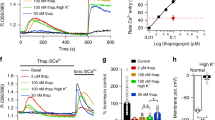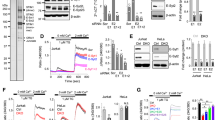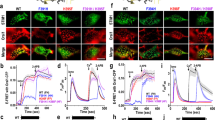Abstract
Physiological Ca2+ signaling in T lymphocytes and other cells depends on the STIM-ORAI pathway of store-operated Ca2+ entry. STIM1 and STIM2 are Ca2+ sensors in the endoplasmic reticulum (ER) membrane, with ER-luminal domains that monitor cellular Ca2+ stores and cytoplasmic domains that gate ORAI channels in the plasma membrane. The STIM ER-luminal domain dimerizes or oligomerizes upon dissociation of Ca2+, but the mechanism transmitting activation to the STIM cytoplasmic domain was previously undefined. Using Tb3+-acceptor energy transfer, we show that dimerization of STIM1 ER-luminal domains causes an extensive conformational change in mouse STIM1 cytoplasmic domains. The conformational change, triggered by apposition of the predicted coiled-coil 1 (CC1) regions, releases the ORAI-activating domains from their interaction with the CC1 regions and allows physical extension of the STIM1 cytoplasmic domain across the gap between ER and plasma membrane and communication with ORAI channels.
This is a preview of subscription content, access via your institution
Access options
Subscribe to this journal
Receive 12 print issues and online access
$189.00 per year
only $15.75 per issue
Buy this article
- Purchase on Springer Link
- Instant access to full article PDF
Prices may be subject to local taxes which are calculated during checkout






Similar content being viewed by others
Accession codes
References
Hoth, M. & Penner, R. Depletion of intracellular calcium stores activates a calcium current in mast cells. Nature 355, 353–356 (1992).
Hoth, M. & Penner, R. Calcium release-activated calcium current in rat mast cells. J. Physiol. (Lond.) 465, 359–386 (1993).
Zweifach, A. & Lewis, R.S. Mitogen-regulated Ca2+ current of T lymphocytes is activated by depletion of intracellular Ca2+ stores. Proc. Natl. Acad. Sci. USA 90, 6295–6299 (1993).
Parekh, A.B. & Putney, J.W. Jr. Store-operated calcium channels. Physiol. Rev. 85, 757–810 (2005).
Roos, J. et al. STIM1, an essential and conserved component of store-operated Ca2+ channel function. J. Cell Biol. 169, 435–445 (2005).
Liou, J. et al. STIM is a Ca2+ sensor essential for Ca2+ -store-depletion-triggered Ca2+ influx. Curr. Biol. 15, 1235–1241 (2005).
Feske, S. et al. A mutation in Orai1 causes immune deficiency by abrogating CRAC channel function. Nature 441, 179–185 (2006).
Vig, M. et al. CRACM1 is a plasma membrane protein essential for store-operated Ca2+ entry. Science 312, 1220–1223 (2006).
Zhang, S.L. et al. Genome-wide RNAi screen of Ca2+ influx identifies genes that regulate Ca2+ release-activated Ca2+ channel activity. Proc. Natl. Acad. Sci. USA 103, 9357–9362 (2006).
Feske, S. ORAI1 and STIM1 deficiency in human and mice: roles of store-operated Ca2+ entry in the immune system and beyond. Immunol. Rev. 231, 189–209 (2009).
Feske, S. Immunodeficiency due to defects in store-operated calcium entry. Ann. NY Acad. Sci. 1238, 74–90 (2011).
Zhang, S.L. et al. STIM1 is a Ca2+ sensor that activates CRAC channels and migrates from the Ca2+ store to the plasma membrane. Nature 437, 902–905 (2005).
Stathopulos, P.B., Li, G.Y., Plevin, M.J., Ames, J.B. & Ikura, M. Stored Ca2+ depletion-induced oligomerization of stromal interaction molecule 1 (STIM1) via the EF-SAM region: an initiation mechanism for capacitative Ca2+ entry. J. Biol. Chem. 281, 35855–35862 (2006).
Brandman, O., Liou, J., Park, W.S. & Meyer, T. STIM2 is a feedback regulator that stabilizes basal cytosolic and endoplasmic reticulum Ca2+ levels. Cell 131, 1327–1339 (2007).
Luik, R.M., Wang, B., Prakriya, M., Wu, M.M. & Lewis, R.S. Oligomerization of STIM1 couples ER calcium depletion to CRAC channel activation. Nature 454, 538–542 (2008).
Stathopulos, P.B., Zheng, L., Li, G.Y., Plevin, M.J. & Ikura, M. Structural and mechanistic insights into STIM1-mediated initiation of store-operated calcium entry. Cell 135, 110–122 (2008).
Cahalan, M.D. STIMulating store-operated Ca2+ entry. Nat. Cell Biol. 11, 669–677 (2009).
Hogan, P.G., Lewis, R.S. & Rao, A. Molecular basis of calcium signaling in lymphocytes: STIM and ORAI. Annu. Rev. Immunol. 28, 491–533 (2010).
Soboloff, J., Rothberg, B.S., Madesh, M. & Gill, D.L. STIM proteins: dynamic calcium signal transducers. Nat. Rev. Mol. Cell Biol. 13, 549–565 (2012).
Huang, G.N. et al. STIM1 carboxyl-terminus activates native SOC, I crac and TRPC1 channels. Nat. Cell Biol. 8, 1003–1010 (2006).
Yuan, J.P. et al. SOAR and the polybasic STIM1 domains gate and regulate Orai channels. Nat. Cell Biol. 11, 337–343 (2009).
Park, C.Y. et al. STIM1 clusters and activates CRAC channels via direct binding of a cytosolic domain to Orai1. Cell 136, 876–890 (2009).
Muik, M. et al. A cytosolic homomerization and a modulatory domain within STIM1 C terminus determine coupling to ORAI1 channels. J. Biol. Chem. 284, 8421–8426 (2009).
Kawasaki, T., Lange, I. & Feske, S. A minimal regulatory domain in the C terminus of STIM1 binds to and activates ORAI1 CRAC channels. Biochem. Biophys. Res. Commun. 385, 49–54 (2009).
Zhou, Y. et al. STIM1 gates the store-operated calcium channel ORAI1 in vitro. Nat. Struct. Mol. Biol. 17, 112–116 (2010).
Liou, J., Fivaz, M., Inoue, T. & Meyer, T. Live-cell imaging reveals sequential oligomerization and local plasma membrane targeting of stromal interaction molecule 1 after Ca2+ store depletion. Proc. Natl. Acad. Sci. USA 104, 9301–9306 (2007).
Walsh, C.M. et al. Role of phosphoinositides in STIM1 dynamics and store-operated calcium entry. Biochem. J. 425, 159–168 (2009).
Ercan, E. et al. A conserved, lipid-mediated sorting mechanism of yeast Ist2 and mammalian STIM proteins to the peripheral ER. Traffic 10, 1802–1818 (2009).
Frischauf, I. et al. Molecular determinants of the coupling between STIM1 and Orai channels: differential activation of Orai1–3 channels by a STIM1 coiled-coil mutant. J. Biol. Chem. 284, 21696–21706 (2009).
Zeng, W. et al. STIM1 gates TRPC channels, but not Orai1, by electrostatic interaction. Mol. Cell 32, 439–448 (2008).
Lefkimmiatis, K. et al. Store-operated cyclic AMP signalling mediated by STIM1. Nat. Cell Biol. 11, 433–442 (2009).
Park, C.Y., Shcheglovitov, A. & Dolmetsch, R. The CRAC channel activator STIM1 binds and inhibits L-type voltage-gated calcium channels. Science 330, 101–105 (2010).
Wang, Y. et al. The calcium store sensor, STIM1, reciprocally controls Orai and CaV1.2 channels. Science 330, 105–109 (2010).
Wu, M.M., Buchanan, J., Luik, R.M. & Lewis, R.S. Ca2+ store depletion causes STIM1 to accumulate in ER regions closely associated with the plasma membrane. J. Cell Biol. 174, 803–813 (2006).
Várnai, P., Tóth, B., Tóth, D.J., Hunyady, L. & Balla, T. Visualization and manipulation of plasma membrane-reticulum contact sites indicates the presence of additional molecular components within the STIM1-Orai1 complex. J. Biol. Chem. 282, 29678–29690 (2007).
Orci, L. et al. STIM1-induced precortical and cortical subdomains of the endoplasmic reticulum. Proc. Natl. Acad. Sci. USA 106, 19358–19362 (2009).
Carrasco, S. & Meyer, T. STIM proteins and the endoplasmic reticulum-plasma membrane junctions. Annu. Rev. Biochem. 80, 973–1000 (2011).
Selvin, P.R. & Hearst, J.E. Luminescence energy transfer using a terbium chelate: improvements on fluorescence energy transfer. Proc. Natl. Acad. Sci. USA 91, 10024–10028 (1994).
Selvin, P.R. Principles and biophysical applications of lanthanide-based probes. Annu. Rev. Biophys. Biomol. Struct. 31, 275–302 (2002).
Xiao, M. et al. An actin-dependent conformational change in myosin. Nat. Struct. Biol. 10, 402–408 (2003).
Cha, A., Snyder, G.E., Selvin, P.R. & Bezanilla, F. Atomic scale movement of the voltage-sensing region in a potassium channel measured via spectroscopy. Nature 402, 809–813 (1999).
Posson, D.J., Ge, P., Miller, C., Bezanilla, F. & Selvin, P.R. Small vertical movement of a K+ channel voltage sensor measured with luminescence energy transfer. Nature 436, 848–851 (2005).
Callaci, S., Heyduk, E. & Heyduk, T. Core RNA polymerase from E. coli induces a major change in the domain arrangement of the σ70 subunit. Mol. Cell 3, 229–238 (1999).
Nath, A., Atkins, W.M. & Sligar, S.G. Applications of phospholipid bilayer nanodiscs in the study of membranes and membrane proteins. Biochemistry 46, 2059–2069 (2007).
Muik, M. et al. STIM1 couples to ORAI1 via an intramolecular transition into an extended conformation. EMBO J. 30, 1678–1689 (2011).
Korzeniowski, M.K., Manjarrés, I.M., Várnai, P. & Balla, T. Activation of STIM1-Orai1 involves an intramolecular switching mechanism. Sci. Signal. 3, ra82 (2010).
Muik, M. et al. Dynamic coupling of the putative coiled-coil domain of ORAI1 with STIM1 mediates ORAI1 channel activation. J. Biol. Chem. 283, 8014–8022 (2008).
Horrocks, W.D. Jr. & Sudnick, D.R. Lanthanide ion probes of structure in biology. Laser-induced luminescence decay constants provide a direct measure of the number of metal-coordinated water molecules. J. Am. Chem. Soc. 101, 334–340 (1979).
Beeby, A. et al. Non-radiative deactivation of the excited states of europium, terbium and ytterbium complexes by proximate energy-matched OH, NH and CH oscillators: an improved luminescence method for establishing solution hydration states. J. Chem. Soc. Perkin Trans. 2, 493–503 (1999).
Martin, L. Development of lanthanide-binding tags (LBTs) as powerful and versatile peptides for use in studies of proteins and protein interactions. PhD thesis, Massachusetts Inst. of Technology (2008).
Williams, R.T. et al. Identification and characterization of the STIM (stromal interaction molecule) gene family: coding for a novel class of transmembrane proteins. Biochem. J. 357, 673–685 (2001).
Covington, E.D., Wu, M.M. & Lewis, R.S. Essential role for the CRAC activation domain in store-dependent oligomerization of STIM1. Mol. Biol. Cell 21, 1897–1907 (2010).
Yang, X., Jin, H., Cai, X., Li, S. & Shen, Y. Structural and mechanistic insights into the activation of Stromal interaction molecule 1 (STIM1). Proc. Natl. Acad. Sci. USA 109, 5657–5662 (2012).
Katchalski-Katzir, E. et al. Design and synthesis of peptides that bind α-bungarotoxin with high affinity and mimic the three-dimensional structure of the binding-site of acetylcholine receptor. Biophys. Chem. 100, 293–305 (2003).
Lau, T.L., Kim, C., Ginsberg, M.H. & Ulmer, T.S. The structure of the integrin αIIbβ3 transmembrane complex explains integrin transmembrane signalling. EMBO J. 28, 1351–1361 (2009).
Anthis, N.J. et al. The structure of an integrin talin complex reveals the basis of inside-out signal transduction. EMBO J. 28, 3623–3632 (2009).
Kim, C., Ye, F. & Ginsberg, M.H. Regulation of integrin activation. Annu. Rev. Cell Dev. Biol. 27, 321–345 (2011).
Sculimbrene, B.R. & Imperiali, B. Lanthanide-binding tags as luminescent probes for studying protein interactions. J. Am. Chem. Soc. 128, 7346–7352 (2006).
Heyduk, T. & Heyduk, E. Luminescence energy transfer with lanthanide chelates: interpretation of sensitized acceptor decay amplitudes. Anal. Biochem. 289, 60–67 (2001).
Ritchie, T.K. et al. Chapter 11: reconstitution of membrane proteins in phospholipid bilayer nanodiscs. Methods Enzymol. 464, 211–231 (2009).
Acknowledgements
This work was funded by US National Institutes of Health grants AI084167 and AI40127 (to A.R. and P.G.H.) and by grants from the Canadian Institutes of Health Research and the Heart and Stroke Foundation of Canada (to M.I.). Y.Z. has been supported by a postdoctoral fellowship from The Leukemia & Lymphoma Society (LLS) and by an LLS Special Fellow award, P.S. by a Human Frontier Science Program cross-disciplinary fellowship and A.G. by a Cancer Research Institute–Irvington Institute Fellowship. We thank Y. Shen (Nankai University, Tianjin, China) for the plasmid pMCSG9-SOAR and S. Sligar (University of Illinois Urbana-Champaign, Urbana, Illinois, USA) for the plasmid pMSP1D1.
Author information
Authors and Affiliations
Contributions
Y.Z. and P.G.H. designed the study. Y.Z. designed engineered proteins, developed the assays and carried out the experiments with assistance from S.R. and S.S. P.S. made a detailed study of STIM1 binding to liposomes. P.M. prepared and characterized liposomes for the binding assays. A.G. contributed recombinant proteins and technical suggestions. P.B.S. and M.I. contributed the SEC-MALS characterization of recombinant CC1. Y.Z., A.R. and P.G.H. analyzed data, with input from the other authors. Y.Z. and P.G.H. wrote the manuscript.
Corresponding author
Ethics declarations
Competing interests
A.R. and P.G.H. are founders of CalciMedica, Inc. and are members of its scientific advisory board.
Supplementary information
Supplementary Text and Figures
Supplementary Figures 1–6, Supplementary Table 1 and Supplementary Note (PDF 6020 kb)
Rights and permissions
About this article
Cite this article
Zhou, Y., Srinivasan, P., Razavi, S. et al. Initial activation of STIM1, the regulator of store-operated calcium entry. Nat Struct Mol Biol 20, 973–981 (2013). https://doi.org/10.1038/nsmb.2625
Received:
Accepted:
Published:
Issue Date:
DOI: https://doi.org/10.1038/nsmb.2625
This article is cited by
-
NNAT is a novel mediator of oxidative stress that suppresses ER + breast cancer
Molecular Medicine (2023)
-
An apical Phe-His pair defines the Orai1-coupling site and its occlusion within STIM1
Nature Communications (2023)
-
Paraquat is an agonist of STIM1 and increases intracellular calcium levels
Communications Biology (2022)
-
Functional investigation of SLC1A2 variants associated with epilepsy
Cell Death & Disease (2022)
-
SOCE in the cardiomyocyte: the secret is in the chambers
Pflügers Archiv - European Journal of Physiology (2021)



